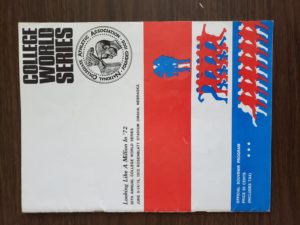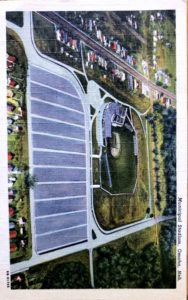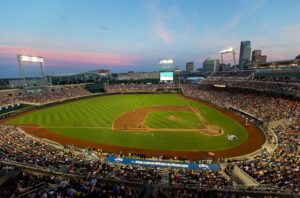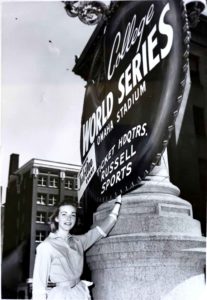After spending three weeks looking at the history and the people behind Omaha’s 70-year relationship with the College World Series, I thought it would be interesting to take a look at the broader impact that the two entities have had on one another and where the relationship stands today.
The first installments cited some figures on the CWS’s modest beginnings, and some of the interviewees featured last week had memories of much smaller crowds in the early days. When Municipal Stadium was being built in the late 1940’s, no one had any idea that the stadium would one day house this national event. It was intended to serve as the home diamond for a local single-A team that didn’t even exist at the time. (The Cardinals wouldn’t start playing in Omaha until 1948.)
Construction for the stadium ran almost $300,000 over budget between 1945 and 1948, and Johnny Rosenblatt worked with the city to approve over $700,000 worth of bond issues to bring the stadium to completion. That’s equivalent to almost $10 million today!
It wasn’t always clear that Omaha would hold onto the title of host city. In 1950, rumors (albeit quickly silenced) began to circulate that the city might not be interested in hosting the following year.[1] In fact, the tournament lost money for ten of the years between 1950 to 1961. Four notable Omaha figures – Ed Pettis (of Brandeis fortune), Byron W. Reed, Morris Jacobs, and Johnny Rosenblatt – saw an investment opportunity and created the College World Series of Omaha, Inc.[2] By the early 1960s, it had become clear that the series could be a great boon for the city, and Omaha leaders and local businesses began to take an interest in guaranteeing that the Series remain in the city and that it turn a profit.
A 1964 article in the Omaha World-Herald reported that four years before, three days of rained-out games and low attendance at the series had resulted in a net loss for the year. By 1964, Omaha underwriters were putting up almost $50,000 to cover any series expenses not met by ticket sales. General Chairman John Diesing was quoted saying, “We’ll never run out of money…even if the rain lasts two months.”[3] One noted supporter of the series that year was Mutual of Omaha, who purchased 2,000 tickets to be used during the first week’s games.[4]
Relations between Omaha stakeholders and the NCAA were not always smooth – in the early 1960’s there were disagreements about the sale of beer at games, as well as the decision to schedule games on Sundays.[5]
But all the while, crowds grew bigger and bigger. In 1972, the College World Series anticipated seeing its millionth fan walk through the gates – that season’s slogan was “Looking Like a Million in ’72,” and in 1988, the championship game was televised for the first time on CBS.
The new TD Ameritrade Park, though perhaps lacking some of Rosenblatt’s charm, is – according to Major League Baseball Commissioner Robert Manfred, Jr. – considered “the best non-MLB facility in North America.” By 2014, cumulative CWS attendance at TD Park reached over 1.3 million – surpassing the millionth-fan milestone that was celebrated in 1972 in just four years.
Luckily for everyone involved, Omaha’s initial investment in building Muny Stadium and its bolstering of the early College World Series has turned into something truly incredible—a study commissioned by CWS of Omaha, Inc. in 2016 concluded that the CWS alone generates about $70 million for Omaha businesses each year.[6] Though the full extent of the effects of the 2020 CWS cancellation haven’t yet been seen, one thing can be sure – Omaha will see another year of great baseball and wonderful fans again next year and for many more years to come!
Natalie Kammerer
[1] “Los Angeles to Seek Tourney if Omaha Doesn’t Want It.” Omaha World-Herald. June 17, 1950.
[2] “CWS History.” CWS Omaha, Inc. http://cwsomaha.com/history/cws-history/
[3] “Despite Rain Problems, CWS Officials Still Hope to Top Crowd Mark of 52,757.” Ibid. June 17, 1950.
[4] “Mutual of Omaha Buys 2,000 – CWS Ticket Sales Show Increase.” Ibid. June 8, 1964.
[5] “Sunday Play Rule Eased – NCAA Sticks to Guns: No Beer at 1964 CWS.” Ibid. August 23, 1963.
[6] Healy, Joe. “’A Massive Blow:’ Omaha Feels Impact Of 2020 College World Series Cancellation.” Baseball America. March 18, 2020. https://www.baseballamerica.com/stories/omaha-feels-impact-of-2020-college-world-series-cancellation/










